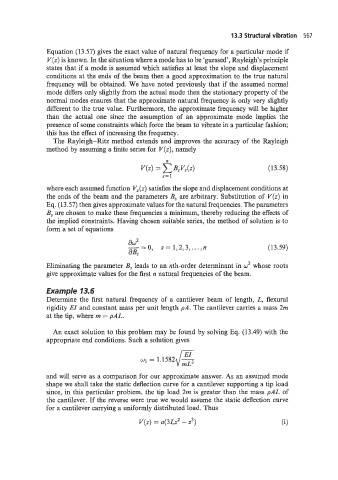Page 586 - Aircraft Stuctures for Engineering Student
P. 586
13.3 Structural vibration 567
Equation (13.57) gives the exact value of natural frequency for a particular mode if
V(z) is known. In the situation where a mode has to be ‘guessed’, Rayleigh’s principle
states that if a mode is assumed which satisfies at least the slope and displacement
conditions at the ends of the beam then a good approximation to the true natural
frequency will be obtained. We have noted previously that if the assumed normal
mode differs only slightly from the actual mode then the stationary property of the
normal modes ensures that the approximate natural frequency is only very slightly
different to the true value. Furthermore, the approximate frequency will be higher
than the actual one since the assumption of an approximate mode implies the
presence of some constraints which force the beam to vibrate in a particular fashion;
this has the effect of increasing the frequency.
The Rayleigh-Ritz method extends and improves the accuracy of the Rayleigh
method by assuming a finite series for V(z), namely
n
W) = B,VS(Z) (13.58)
s=l
where each assumed function Vs(z) satisfies the slope and displacement conditions at
the ends of the beam and the parameters B, are arbitrary. Substitution of V(z) in
Eq. (13.57) then gives approximate values for the natural frequencies. The parameters
Bs are chosen to make these frequencies a minimum, thereby reducing the effects of
the implied constraints. Having chosen suitable series, the method of solution is to
form a set of equations
83
-= 0, s=1,2,3 ,..., n (13.59)
8B.Y
Eliminating the parameter B, leads to an nth-order determinant in w2 whose roots
give approximate values for the first n natural frequencies of the beam.
Example 13.6
Determine the first natural frequency of a cantilever beam of length, L, flexural
rigidity EZ and constant mass per unit length PA. The cantilever carries a mass 2m
at the tip, where MI = PAL.
An exact solution to this problem may be found by solving Eq. (13.49) with the
appropriate end conditions. Such a solution gives
w1 = 1.1582E
2nd will serve as a comparison for our approximate answer. As an assumed mode
shape we shall take the static deflection curve for a cantilever supporting a tip load
since, in this particular problem, the tip load 2m is greater than the mass PAL of
the cantilever. If the reverse were true we would assume the static deflection curve
for a cantilever carrying a uniformly distributed load. Thus
V(z) = a(3Lz2 - z3) (i)

